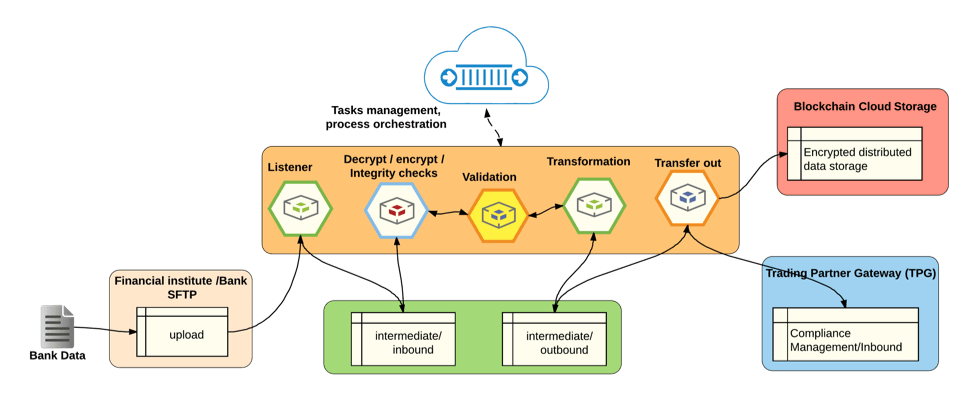Expandable File Based Integration with Microservices
Traditionally, Managed File Transfer (MFT) platforms provide a set of the core capabilities that are needed to perform file based integrations. These capabilities are hard wired in the platform and the end user, or the implementer, will program or configure the components to build needed file transfer workflows. Some of the most common capabilities that are available with traditional MFT platforms are:
- Ingestion & delivery – Push or pull over standard protocols like FTP, SFTP, SCP, FTPS
- Validation – File content validation based on define rules
- File integrity checks – ensuring the file has not been altered in the transit
- Transformation based on defined rules sets
- Merge and split for advanced use cases
- Encryption and decryption in transit and at rest
- TLS authentication, digital certificates and non-repudiation
With RoboMQ all of these components are built as microservices, or Docker containers. RoboMQ MFT platform does it all and more…

Figure 1: MFT workflow with RoboMQ microservices
In a MFT workflow built with RoboMQ each of the functional components are microservices depicted as hexagons in the figure above. The microservices follow task worker pattern and can be infinitely chained to enhance the workflow functionality. The microservices are chained using AMQP based Message Oriented Middleware (MOM) that provides guaranteed delivery and tracks the metadata, or the progress of the file processing. RoboMQ integration middleware provides comprehensive error handling, alerts, notifications and error analytics that in built out of the box. You can get email, SMS or a phone call when any business workflow exception occurs. It can also create a case in the ticketing system like ServiceNow or Jira for the operations team to get engaged. Since MFT is built on state of the art microservices based Hybrid Integration Platform (HIP), there are significant benefits of the new architecture based on container, microservices and hybrid clouds.
- Docker microservices based components – Each of the file listener, validator, transformer and encryption/decryption components are all built as Docker containers. MFT thus inherits advantages of container architecture like:
- Auto-healing – Ability to automatically restart services in case of failures
- Auto-scaling – components can be scaled as needed based on load or the characteristics of the workflow. For example, if the transformation is costly in terms of the processing then more than one transformers can be run with only one of the validators and transfer in and out microservices.
- Almost Zero deployment cost – Functional components run as self-contained autonomous execution units that reduces installation and deployment cost to zero.
- On-premise, on-cloud or hybrid cloud – MFT components can be run on-premise, fully on public or private cloud or in a hybrid configuration where some components run on cloud and some on premise providing the best of the both world.
- Expandable workflow – New functionality can be added or chained to the existing workflow to provide new business feature sets. One of the example of such expansion is the recent addition of the Blockchain Hyperledger Integration with MFT.
- File to/from API integration – The files can be integrated with REST, SOAP, Json or XML APIs by breaking file records to events or collecting events and dispatching them as Files. These features open up possibilities to integrate older file based systems with new generation cloud and SaaS applications.
In summary, RoboMQ MFT provides core file handling and processing capabilities that are built for the world of hybrid cloud and containers allowing modernization by integrating file based systems with SaaS and cloud systems with enhanced security, data transformation and expandable functionality sets.
